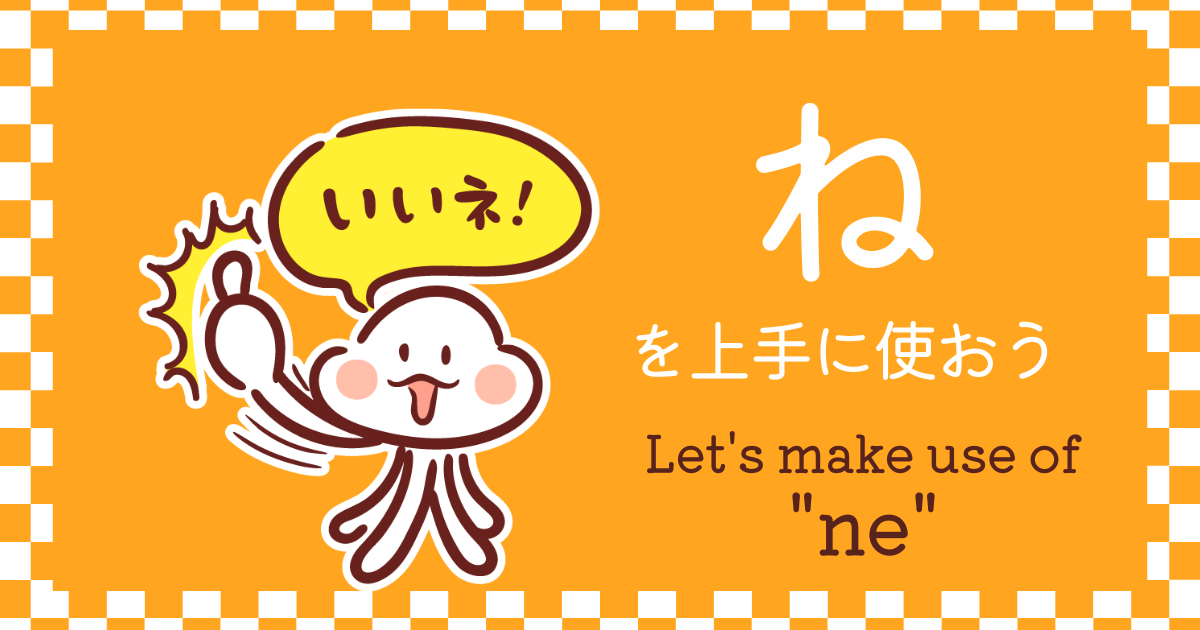
へぇ、それはたいへんでしたね。
Oh, I feel for you.

そうですよ
Yes

(・.・;)すみません…
…sorry…
終助詞(文末のことば)によってニュアンスが変わる
上記の会話の中で「そうですよ」と言われて、なぜ聞き手が「すみません」と返してしまったのかわかりますか?
実は聞き手は責められている、または怒られたように感じてしまったからなんです。会話の中で相槌を打ちたいとき、同じyesの意味でも「そうですよ」ではなく「そうですね」と言ったほうが柔らかい印象を与えます。
このたった一文字の違いで話の印象が大きく変わります。日本語では終助詞を使い分けることによって話し手の感情を表すことができます。
Sentence-final particle expresses the nuance
Do you know why the listener responded “I’m sorry” after being told ”Soudesuyo” ?
Actually, it is because he felt as if he was being blamed or offended. When you want to give verbal feedback, you can say “Soudesune” instead of ” Soudesuyo”. It gives a softer impression even if you mean the same “yes”.
This single difference in one character can make a big difference in the impression. In Japanese, the speaker’s emotions can be expressed by using different sentence-final particles.
終助詞「ね」が持つニュアンス
「今日は暑いですね」ー「そうですね」
「お昼何がいい?」ー「そばが食べたいね」
「3名様ですね」
「遅刻しないようにね」
終助詞「ね」は共感、同意、確認、依頼などの使い方があります。
「ね」には相手と情報や感情を共有したり、確認し合ったりと、相手に働きかける機能があります。会話を一緒に作り上げていきたいというサインになるため、「ね」をつけると柔らかい印象を与えます。
The nuance of “ne”
“Kyou wa atsuidesune”-“Soudesune”
(It’s hot today. – Yes, it is.)
” Ohiru nani ga ii?”-“Soba ga tabetaine”
(What do you want for lunch? – I want soba)
“Sanmeisama desune”
(Three people, sir.)
”Chikoku sinaiyounine”
(Don’t be late.)
The sentence-final particle “ne” can be used to express sympathy, agreement, confirmation, or a request.
You can suggest a talk or action by sharing or confirming information or feelings with “ne”. It is a sign that you want to build a conversation together, so adding “ne” gives a softer impression.
終助詞「よ」が持つニュアンス
「これは静岡産ですか?」ー「そうですよ」
「味はどう?」ー「すごくおいしいよ!」
「ハンカチ落としましたよ」
「私のこと忘れないでよ」
終助詞「よ」には情報提供、注意、主張などの役割があります。聞き手が知らない情報、気づいていないことを伝えて注意や理解を促します。
The nuance of “yo”
“Korewa Shizuokasan desuka?”-“Soudesuyo”
(Is this from Shizuoka?- Yes.)
“Ajiwa dou?”-“Sugoku oishiiyo!”
(How does it taste?- Very good!)
“Hankachi otoshimashitayo”
(You dropped your handkerchief.)
“Watashinokoto wasurenaideyo”
(Don’t forget about me.)
The final particle “yo” has the role of providing information, attention, and assertion. It conveys information that the listener is unknown to or unaware of, and promotes attention and understanding.
まとめ
「ね」は会話を一緒に構築していくイメージに対して、「よ」には、相手に情報を伝える一方方向的なイメージがあります。
会話の中で「そうですね」というなら、同意や協調を意図とした相槌になります。「そうですよ」は確認事項を明確にするときによく使われます。
上記の会話の場合、「よ」をつけるときは知らない情報を伝えているという背景から、「あなたは知らないの?」というニュアンスで伝わってしまっていることがあるのです。
使った表現が何故か冷たく聞こえる、ネガティブに聞こえるというのは言語学習によくあることですね。でもその理由がネイティブスピーカーでも説明できないこともしばしば。学習者に言われて初めて気づくのです。
Summary
While “ne” has the image of building a conversation together, “yo” has the one-directional image of conveying information to the other person.
If you say “Soudesune” in a conversation, it is a form of verbal feedback intended to convey agreement or cooperation. Then,”Soudesuyo” is often used to clarify a point of confirmation.
In the case of the above conversation, when using “yo,” makes the nuance of “you don’t know?” Because “yo” is used for conveying unknown information.
It is common in language learning that the expressions we use sound cold or negative for some reason. But often even native speakers can’t explain why. We don’t realize it until the learner tells us.




コメント